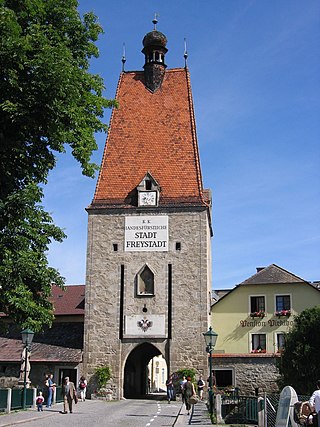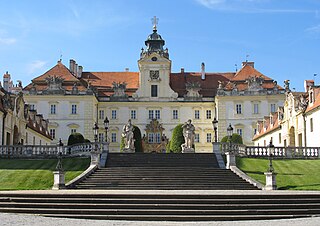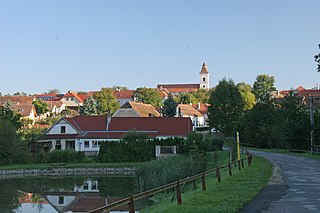
Znojmo is a town in the South Moravian Region of the Czech Republic. It has about 34,000 inhabitants. Znojmo is the historical and cultural centre of southwestern Moravia and the second most populated town in the South Moravian Region. The historic centre of Znojmo is well preserved and is protected by law as an urban monument reservation.

Puchberg am Schneeberg is a town in the south-eastern part of Lower Austria with approximately 2650 inhabitants. It is situated about 80 Kilometres from Vienna. The highest point of Puchberg is the Schneeberg with 2076 m, the highest mountain of Lower Austria.

Břeclav is a town in the South Moravian Region of the Czech Republic. It has about 25,000 inhabitants.

Mikulov is a town in Břeclav District in the South Moravian Region of the Czech Republic. It has about 7,600 inhabitants. The historic centre of Mikulov is well preserved and is protected by law as an urban monument reservation.

Šumperk is a town in the Olomouc Region of the Czech Republic. It has about 25,000 inhabitants. It is an industrial town, but it also contains valuable historical and architectural monuments. The historic town centre is well preserved and is protected by law as an urban monument zone.

Laa an der Thaya is a town in the Mistelbach District of Lower Austria in Austria, near the Czech border. The population in 2016 was 6,224.

Gloggnitz is a mountain town in the Neunkirchen district of Lower Austria, Austria.

Freistadt is a small Austrian town in the state of Upper Austria in the region Mühlviertel. With a population of approximately 7,500 residents, it is a trade centre for local villages. Freistadt is the economic centre of a district of the same name District Freistadt. The nearest sizeable cities are Linz, the capital of Upper Austria, about 40 km in the south, and České Budějovice, the capital of Southern Bohemia, about 60 km in the north.

Valtice is a town in Břeclav District in the South Moravian Region of the Czech Republic. It has about 3,600 inhabitants. It is known as part of Lednice–Valtice Cultural Landscape, a UNESCO World Heritage Site. The historic town centre is well preserved and is protected by law as an urban monument zone.

Mistelbach an der Zaya is a town in the northeast of Austria in Lower Austria, one of Austria's nine federal states. It is located roughly 40 km northeast of Austria's capital Vienna. Furthermore, it consists of 8 subordinated municipalities.

Stockerau is a town in the district of Korneuburg in Lower Austria, Austria. Stockerau has 16,974 inhabitants, which makes it the largest town in the Weinviertel. Stockerau is also called "Lenaustadt" because the Austrian poet Nikolaus Lenau often spent time with his grandparents here.

Moravský Krumlov is a town in Znojmo District in the South Moravian Region of the Czech Republic. It has about 5,700 inhabitants. The historic town centre is well preserved and is protected by law as an urban monument zone.
Großrußbach is a town in the district of Korneuburg in Lower Austria in Austria

Hardegg is a town in the district of Hollabrunn in Lower Austria, Austria. It is situated in the Waldviertel region on the river Thaya, directly on the border with the Czech Republic. The Thaya valley is protected as the Thayatal National Park, adjacent to the Podyjí National Park on the Czech shore.
Dimbach is a municipality in the district Perg in Upper Austria, Austria. It had a population of 1015 according to the 2015 census.

Lukov is a market town in Znojmo District in the South Moravian Region of the Czech Republic. It has about 300 inhabitants.

Šatov is a market town in Znojmo District in the South Moravian Region of the Czech Republic. It has about 1,200 inhabitants.

Vratěnín is a market town in Znojmo District in the South Moravian Region of the Czech Republic. It has about 300 inhabitants.

The Wachau is an Austrian valley with a picturesque landscape formed by the Danube river. It is one of the most prominent tourist destinations of Lower Austria, located midway between the towns of Melk and Krems that also attracts "connoisseurs and epicureans" for its high-quality wines. It is 36 kilometres (22 mi) in length and was already settled in prehistoric times. A well-known place and tourist attraction is Dürnstein, where King Richard I of England was held captive by Leopold V, Duke of Austria. The architectural elegance of its ancient monasteries, castles and ruins combined with the urban architecture of its towns and villages, and the cultivation of vines as an important agricultural produce are the dominant features of the valley.
The siege of Retz was a conflict between the Holy Roman Empire and the Kingdom of Hungary in 1486. It was part of the Austro-Hungarian War. The Hungarian capture of the town eventually led to the prosperity of its wine industry.
























